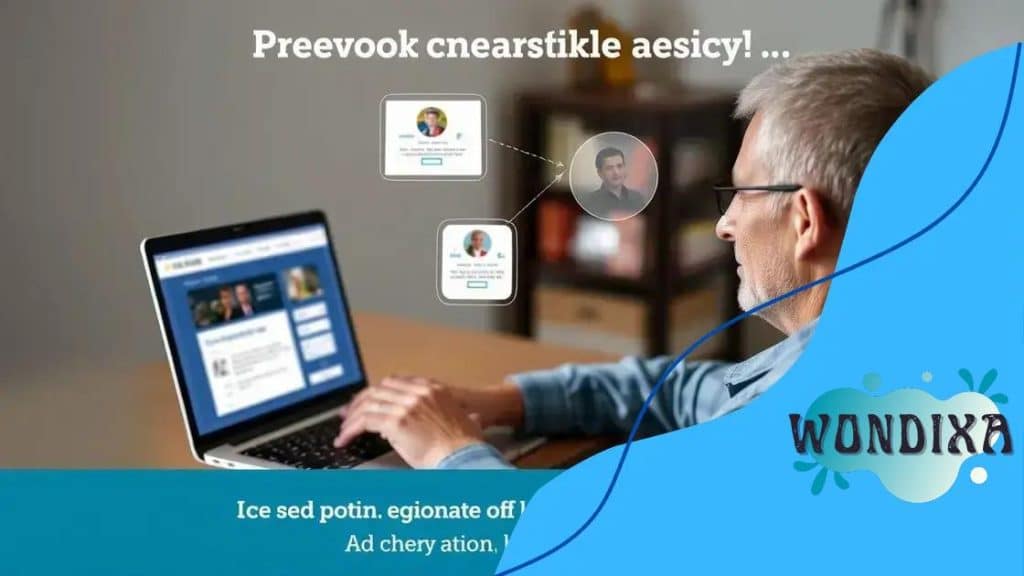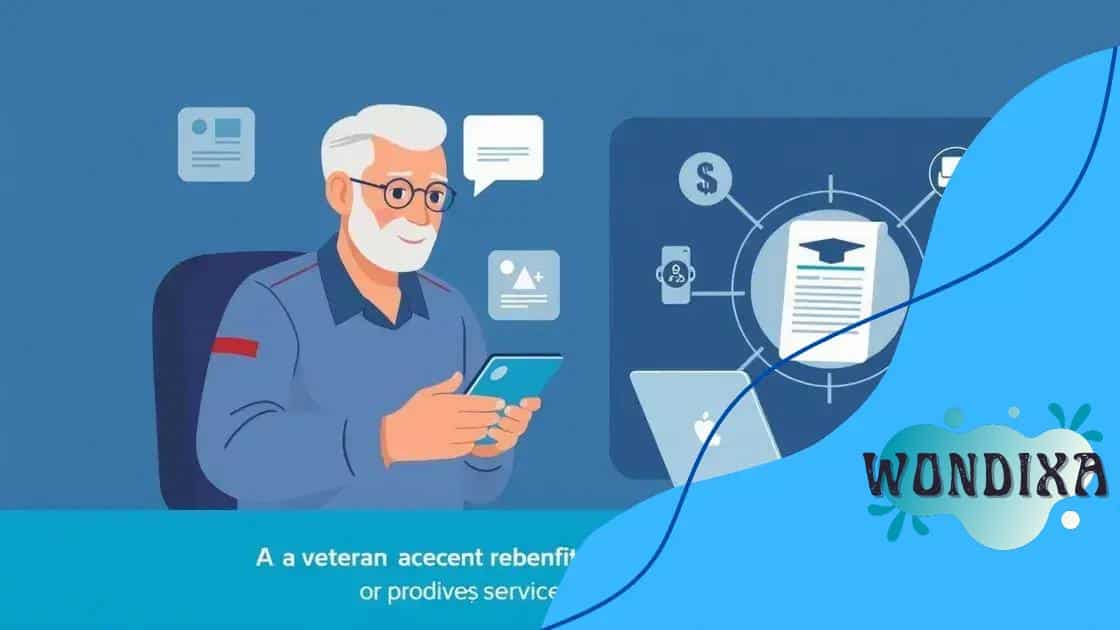Veterans’ benefits modernization and tech integration

Veterans’ benefits modernization and tech integration enhance access and efficiency, utilizing AI, mobile apps, and telehealth to improve how veterans receive services and manage their health care.
Veterans’ benefits modernization and tech integration are crucial in enhancing the support system for our veterans. As we explore the intersection of technology and benefits, it raises questions about accessibility and efficiency that directly affect their lives.
Challenges in the current veterans’ benefits system
The challenges in the current veterans’ benefits system are significant and multifaceted. Veterans often struggle with navigating the complex processes required to access their benefits. Many find the system overwhelming, which can delay the help and resources they need.
One of the key issues is the lack of clarity in the application procedures. Veterans may be unsure about what documents are needed or how to fill out the necessary forms. This confusion can lead to mistakes, requiring additional time and effort to resolve.
Persistent barriers to access
Another challenge is the persistent barriers to access for many veterans. Whether due to physical distance from VA offices or limited knowledge of available resources, support can be hard to come by. Many veterans live in rural areas, where access to services can be a major hurdle.
- Geographical limitations impact service availability.
- Complex eligibility criteria leave some veterans without support.
- Limited outreach programs fail to inform veterans of their options.
Furthermore, technology plays a dual role in this scenario. While advancements can streamline applications, not all veterans have the digital literacy to utilize online services effectively. This digital divide can further complicate their access to benefits.
Administrative inefficiencies
Administrative inefficiencies within the system also contribute to delays. Backlogs in processing claims can leave veterans waiting for months, sometimes even years, for necessary benefits. These delays can exacerbate existing health and financial challenges.
- Claims processing times often exceed expectations.
- Inconsistent communication from the VA creates frustration.
- High volumes of applications overwhelm the system.
Ultimately, addressing these challenges requires a holistic approach that focuses on improving systems, increasing accessibility, and fostering better communication. By prioritizing these areas, we can work towards a more efficient veterans’ benefits system that serves those who have served our country.
The role of technology in improving veteran services
The role of technology in improving veteran services is becoming increasingly important. Innovative tools and systems are being developed to enhance the experiences of veterans seeking assistance. By leveraging modern technology, organizations can provide better support and streamline processes.
Technology enables faster communication between veterans and service providers. Through various platforms, veterans can access information quickly, reducing their wait times and improving satisfaction. These advancements can significantly impact the way veterans receive information about benefits.
Streamlining Processes
One of the primary advantages of technology is its ability to streamline processes. Online portals allow veterans to complete applications and access services from the comfort of their homes. This is especially beneficial for those who may face physical barriers to travel.
- Veterans can submit claims easily and track their status online.
- Automated systems reduce the chances of human error in processing.
- Virtual consultations can provide veterans with immediate support.
Additionally, mobile apps are changing the landscape of veteran services. These applications offer up-to-date resources and reminders, ensuring that veterans stay informed about their benefits. They can receive alerts for upcoming appointments or deadlines, making it easier to manage their needs efficiently.
Enhancing Accessibility
Accessibility is another important area where technology shines. Tools like telehealth have proven invaluable, especially for veterans residing in remote locations. Through telehealth, veterans can connect with healthcare providers without the need to travel long distances.
- Telehealth provides essential medical services, making care accessible.
- Veterans can attend therapy sessions from home, which reduces stigma.
- Remote monitoring tools help manage chronic conditions effectively.
Moreover, data analytics can be utilized to identify the unique needs of veterans, allowing for tailored programs and services. By analyzing trends and outcomes, organizations can better understand how to serve veterans effectively, leading to improved satisfaction and success rates.
Overall, the integration of technology into veteran services not only enhances accessibility but also empowers veterans to take charge of their benefit processes. The ongoing advancements in this space hold promise for a brighter future for those who have served our country.
How modernization impacts the delivery of benefits

The modernization of veteran benefits has significantly impacted how services are delivered. It creates an environment where veterans can access their resources more efficiently than ever before. This shift allows for real-time updates and better communication between veterans and service providers.
As systems evolve, the administrative processes are streamlined. For instance, applications can now be submitted online, reducing the time needed to complete paperwork. This modernization minimizes errors and speedily processes claims, allowing veterans to receive benefits faster. Such efficiency can make a big difference in their lives.
Improved Communication
Another vital impact of modernization is improved communication. Many organizations now use digital platforms to connect with veterans. This approach enables instant notifications regarding their application status or upcoming deadlines. With clear updates, veterans feel more informed and engaged throughout the process.
- Online messaging systems provide immediate assistance.
- Increased transparency builds trust between veterans and agencies.
- Veterans can easily access information anywhere and anytime.
Moreover, telemedicine services have become a critical aspect of modernization. Veterans can now consult healthcare providers remotely, which is particularly beneficial for those in remote areas. This access ensures that veterans receive the care they need without the stress of long travel times.
Customization of Services
Modern technologies also allow for the customization of services. Through data analytics, agencies can identify specific needs and tailor their offerings accordingly. This ensures that each veteran gets the support that is most relevant to their situation, enhancing overall satisfaction.
- Personalized plans can address individual health issues.
- Targeted outreach programs can inform veterans about available resources.
- Feedback loops help agencies improve services based on user experiences.
These advancements create a more inclusive system for veterans, allowing them to feel valued and supported. By embracing modernization, the delivery of benefits becomes not only more effective but also more compassionate, meeting the needs of those who have bravely served.
Real-life success stories of tech integration in veteran care
Real-life success stories of tech integration in veteran care showcase how innovative solutions can transform lives. These examples demonstrate the positive impact of technology on veterans’ access to services and health care.
For instance, in several hospitals, virtual reality (VR) therapy has been used to help veterans cope with PTSD. By engaging with immersive environments, veterans can face their fears in a controlled setting, leading to remarkable improvements in their mental health. Many report feeling more at ease and less isolated.
Telehealth Enhancements
Another compelling story involves telehealth services. During the pandemic, many veterans turned to telehealth for necessary medical consultations. A veteran named John used these services to manage his chronic condition without traveling for hours to the nearest clinic. The convenience of accessing care from home led to better health management and increased satisfaction with his treatment.
- Timely follow-ups enabled quicker adjustments to his medication.
- Reduced travel stress improved his overall quality of life.
- Regular virtual check-ins made him feel supported and engaged.
Moreover, mobile apps designed specifically for veterans have proven effective. One app helps veterans track their medication and appointments. Sarah, a veteran who struggles with organization, found that setting reminders greatly improved her ability to adhere to her treatment plan. As a result, her health outcomes have significantly improved.
Community Support Initiatives
Communities have also utilized technology to support veterans. Local organizations developed platforms where veterans can find peer support and share experiences online. This initiative has fostered a sense of belonging among veterans who often feel isolated. The stories shared on these platforms highlight resilience and camaraderie, showcasing how technology can create vital connections.
- Veterans can share challenges and receive encouragement.
- Access to resources and local events enhances community ties.
- These platforms provide informative content tailored to veterans’ needs.
Overall, these real-life success stories illustrate the transformative potential of technology in veteran care. As we continue to integrate innovative solutions, the future looks promising for veterans seeking improved support and connection.
Future trends in veterans’ benefits and technology
The future trends in veterans’ benefits and technology are shaping how services are delivered. As technology continues to evolve, we can expect more innovative solutions tailored to veterans’ needs. These advancements aim to enhance accessibility, streamline processes, and improve overall satisfaction.
One significant trend is the rise of artificial intelligence (AI) in processing claims. AI can analyze vast amounts of data quickly, helping to identify patterns and expedite the claim process. Veterans may see their applications approved faster, reducing the long wait times that have often frustrated many.
Increased Use of Mobile Technology
Mobile applications are also set to play a larger role in veterans’ lives. More apps are being developed to help veterans access resources on-the-go. These apps can provide crucial reminders for appointments, medication tracking, and even direct communication with healthcare providers. This mobility enhances convenience and keeps veterans engaged in their care.
- Easy access to resources boosts veterans’ ability to manage their benefits.
- Mobile tools allow for real-time communication with support staff.
- Custom reminders enhance adherence to health plans.
Another trend is the broader implementation of telehealth services. As technology continues to advance, telehealth can expand beyond basic consultations. Future developments may allow for interactive sessions where veterans can connect with mental health professionals or physical therapists in real-time, ensuring they receive comprehensive care from their homes.
Data-Driven Insights
Furthermore, utilizing data analytics will help tailor services specifically for veterans. By gathering data on individual health needs and service usage, organizations can create targeted programs. This focus on personal health data can lead to better health outcomes and more personalized care.
- Data analytics can identify trends in health issues among veterans.
- Tailored services mean more effective treatments for unique conditions.
- Insights will help agencies allocate resources more effectively.
As these trends unfold, it’s crucial to involve veterans in the development of new technologies. Gathering feedback from the veteran community ensures that the tools being created truly meet their needs and enhance their experiences. This collaborative approach will lead to improved services and a stronger support system for those who have served.
FAQ – Frequently Asked Questions about Veterans’ Benefits Modernization
How does technology improve veterans’ access to benefits?
Technology streamlines the application process, reduces wait times, and allows veterans to access services online, making it much easier to obtain the support they need.
What is the role of telehealth in veteran care?
Telehealth offers convenient access to medical services for veterans, allowing them to consult with healthcare providers remotely, which is especially beneficial for those in rural areas.
Can mobile apps help veterans manage their benefits?
Yes, mobile apps can provide reminders for appointments, track medications, and facilitate communication with healthcare providers, improving overall management of benefits.
How does AI contribute to processing claims for veterans?
AI can analyze large amounts of data quickly and accurately, helping to identify patterns and expedite the claims process, ultimately allowing veterans to receive benefits faster.





